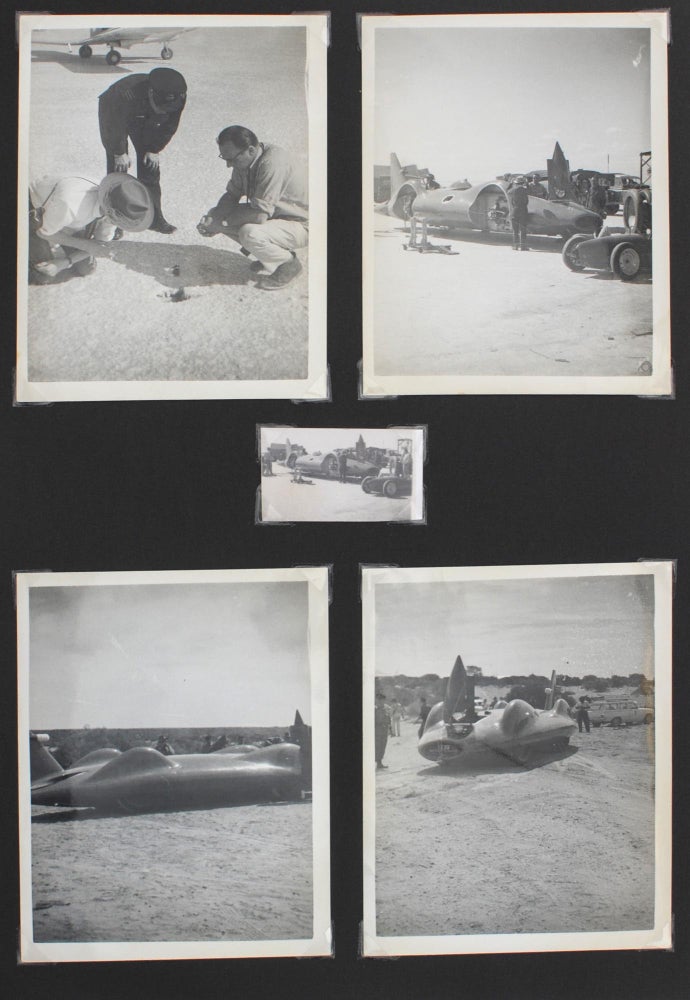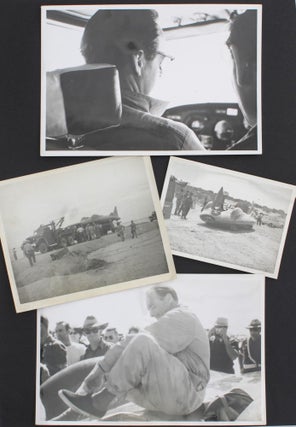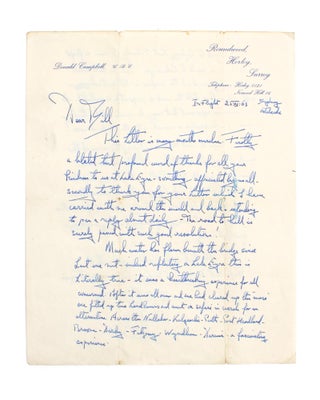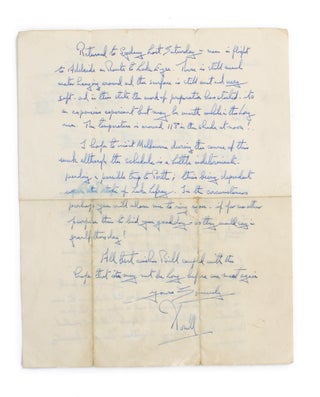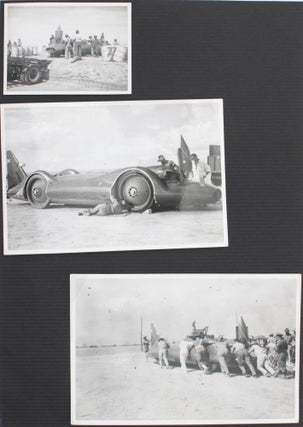An album of photographs of the unsuccessful 1963 attempt on the World Land Speed Record by Donald Campbell at Lake Eyre in South Australia
There are 45 original gelatin silver photographs mounted on 16 pages (nine leaves) of A4 card; most are loosely inserted in photo-corners, and eleven (on three pages) are mounted with small pieces of Blu-Tack (easily removable adhesive putty). The leaves are inserted in plastic sleeves in a plastic-ring binder. The photographs are in three different sizes (in both portrait and landscape formats): 100 x 155 mm (20); 90 x 110 mm (16, plus a miniature duplicate of one of these); and 65 x 90 mm (8). All photographs are in fine condition. The photographer is unidentified; presumably he was unofficial but part of the support team. Two foolscap folio sheets (four pages) of processed typescript notes 'compiled as a result of a conference called by the South Australian Commissioner of Police' are loosely inserted; they go into great detail about the numerous 'certain conditions as laid down by the Authorities' that visitors to the 'Lake Eyre area during the land speed record attempt must be prepared to accept'. Prominent in three of the photographs is a field ambulance; perhaps this is the link between the photographer and his presence at the camp. 'In 1956, Campbell began planning a car to break the land speed record, which then stood at 394 mph (630 km/h). The Norris brothers designed Bluebird CN7 with 500 mph (800 km/h) in mind. The CN7 was completed by the spring of 1960 ... [and] was taken to the Bonneville Salt Flats in Utah, USA, scene of his father's last LSR triumph in 1935. The attempt was unsuccessful and CN7 was written off following a high-speed crash in September at Bonneville. Campbell was not seriously hurt, suffering a fracture to his lower skull, and was by 1961 on the road to recovery and planning the rebuild of CN7. The rebuilt car was completed, with minor modifications, in 1962 and, by the end of the year, was shipped to Australia for a new attempt at Lake Eyre in 1963. The Lake Eyre location was chosen as it offered 450 square miles (1,170 km²) of dried salt lake, where rain had not fallen in the previous 20 years, and the surface of the 20 miles (32 km) long track was as hard as concrete. As Campbell arrived in late March, with a view to a May attempt, the first light rain fell. Campbell and Bluebird were running by early May but once again more rain fell, and low-speed test runs could not progress into the higher speed ranges. By late May, the rain became torrential, and the lake was flooded. Campbell had to move the CN7 off the lake in the middle of the night to save the car from being submerged by the rising flood waters. The 1963 attempt was over'. Twenty of the photographs in this album feature CN7 (generally prominently), and in a further eight Donald Campbell is clearly visible. There is a later variant of the well-known (dare we say iconic?) image of the two skeletal cows behind the 'wheel' which appears in Pearson's 1965 book (see below), as well as sundry shots around the Bluebird camp. It seems likely the photographs were taken early in piece, as the lake is not yet in flood. 'Campbell and his team returned to Lake Eyre in 1964, but the surface never returned to the promise it had held in 1962 and Campbell had to battle with CN7 to reach record speeds (400+ mph). After more light rain in June, the lake finally began to dry enough for an attempt to be made. On July 17, 1964, Campbell set a record of 403.10 mph for a four-wheeled vehicle'. He went on to set a new water speed record of 276.33 mph on 31 December at Lake Dumbleyung, near Perth, WA. 'He had become the first, and so far only, person to set both land and water speed records in the same year. Campbell's land record was short-lived, because rule changes meant that Craig Breedlove's Spirit of America, a pure jet car, would begin setting records later in 1964 and 1965. Campbell's 429 mph speed on his final Lake Eyre run, however remained the highest speed achieved by a wheel-driven car until 2001' (all major quotes from Wikipedia). He met his death on 4 January 1967 when his boat Bluebird K7 disintegrated at a speed in excess of 300 mph on Coniston Water in Cumbria. The standard work on Campbell and Lake Eyre, 'Bluebird and the Dead Lake' by John Pearson, was published in 1965. It contains just 21 plates; one from 1935, one from 1960 and the balance almost certainly all from 1964. (One clue to distinguishing between the two Lake Eyre excursions is that BP gave way to Ampol as major sponsors in late 1963). This album adds a new visual dimension to this fascinating story. Adding yet more significance to the album is the presence of an autograph letter signed by Donald Campbell (two pages quarto, on Campbell's Roundwood, Horley, Surrey letterhead: 'In Flight 25:XI:63 Sydney - Adelaide'). The letter is addressed to 'Bill', unidentified, possibly from Melbourne, but Campbell offers his 'belated but profound word of thanks for all your kindness to us at Lake Eyre.... Much water has flown under the bridge since last we met - indeed reflecting on Lake Eyre this is literally true - it was a heartbreaking experience for all concerned. After it was all over and we had cleaned up the "mess" we filled up two Land Rovers and went on safari in search for an alternative. Across the Nullabor [sic] - Kalgoorlie - Perth - Port Headland [sic] - Broome - Derby - Fitzroy - Wyndham - Darwin - a fascinating experience'. The letter is written while Campbell is in the air, en route via Adelaide to Lake Eyre. 'There is still much water hanging around and the surface is still wet and very soft - and in this state the work of preparation has started - it's an expensive experiment but may be worth while in the long run'.
Item #106376
Sold

